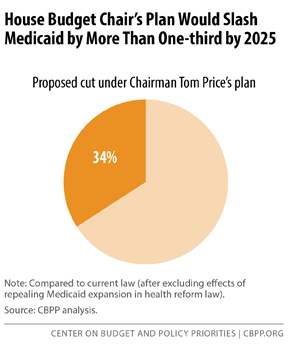BEYOND THE NUMBERS
Update, March 17: We’ve updated this post to reflect that the House Budget Committee used the Congressional Budget Office’s January 2015 baseline in preparing its plan rather than CBO’s March 2015 baseline.
House Budget Committee Chairman Tom Price’s budget plan proposes to radically restructure Medicaid by converting it to a block grant and cutting federal funding for it steeply, by $913 billion over the next decade. It would also repeal health reform’s Medicaid expansion. The combined Medicaid cut would reach $1.8 trillion over ten years, relative to current law, adding tens of millions of Americans to the ranks of the uninsured and underinsured.
Repealing health reform’s Medicaid expansion means that at least 14 million people would lose their Medicaid coverage or no longer gain coverage in the future. (That’s the number of people who the Congressional Budget Office [CBO] estimates would eventually gain coverage under the Medicaid expansion, though it could reach 17 million if all states adopt the expansion.) In addition, the large and growing cut in federal Medicaid funding from the block grant would almost certainly force states to sharply scale back or eliminate Medicaid coverage for millions of low-income people who have it today. All told, after accounting for the plan’s proposed repeal of health reform’s marketplace subsidies, tens of millions of people would likely become uninsured under Chairman Price’s plan.
Under the Price plan, the federal government would no longer pay a fixed share of states’ Medicaid costs, starting in 2017. Instead, states would get a fixed dollar amount of federal funding known as “State Flexibility Funds.” (The budget plan doesn’t specify how it would set each state’s block grant amounts initially or adjust them each year.)
-
The block grant funding would fall further behind state needs each year. The annual increase in the overall block grant funding would average about 4.7 percentage points less than Medicaid’s current projected growth rate over the next ten years, which accounts for factors like rising health care costs and the aging of the population. Federal Medicaid and Children’s Health Insurance Program (CHIP) spending in 2025 would be $161 billion — or nearly 34 percent — less than what states would receive under current law, according to the budget plan (see chart). And the cuts would likely keep growing after 2025.
-
Altogether, the block grant would cut federal Medicaid spending by $913 billion from 2016-2025; a small share of these cuts could come from CHIP, which the Price plan would merge into its new Medicaid block grant. That would cut federal Medicaid and CHIP funding by nearly 24 percent over the next ten years, compared to current law — and that doesn’t count the loss of the large amount of additional funding that states would receive to expand Medicaid under health reform.
-
The loss of federal funding would be greater in years when enrollment or per-beneficiary health care costs rose faster than expected, such as during a recession or after the introduction of a new breakthrough health care technology or treatment that improved patients’ health but raised costs. Currently, the federal government and the states share in those unanticipated costs; under the Price plan, states alone would bear them.
As CBO concluded when analyzing a similar Medicaid block grant proposal from former House Budget Committee Chairman Paul Ryan’s budget plan of three years ago, “the magnitude of the reduction in spending . . . means that states would need to increase their spending on these programs, make considerable cutbacks in them, or both. Cutbacks might involve reduced eligibility, . . . coverage of fewer services, lower payments to providers, or increased cost-sharing by beneficiaries — all of which would reduce access to care.”
In making these cuts, states would likely use the expansive additional flexibility that the Price plan would give them. For example, the plan would likely let states cap Medicaid enrollment and turn eligible people away from the program; under current law, states must accept all eligible individuals who apply. It also would likely let states drop certain benefits that people with disabilities or other special health problems need.
The Urban Institute estimated that former Chairman Ryan’s similar block grant proposal in 2012 would lead states to drop between 14.3 million and 20.5 million people from Medicaid by the tenth year (outside of the effects of repealing health reform’s Medicaid expansion). That would cause a drop in enrollment of between 25 percent and 35 percent. The Urban Institute also estimated that the block grant likely would have caused cuts in reimbursements to health care providers of more than 30 percent by the tenth year. Chairman Price’s Medicaid block grant proposal likely would mean similarly draconian cuts.

